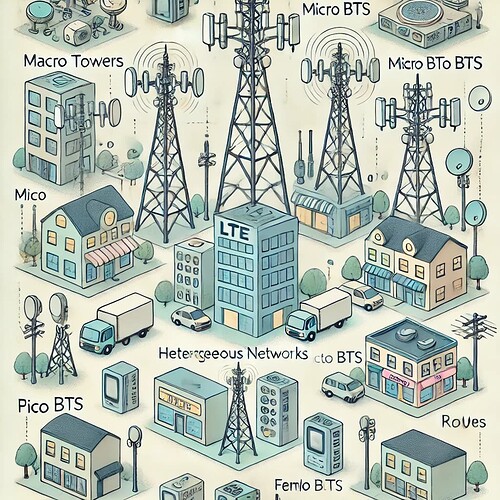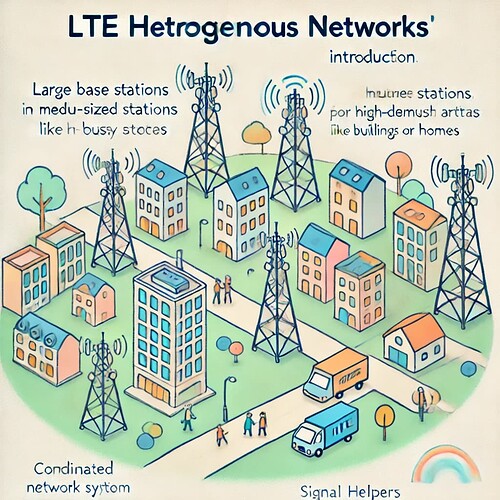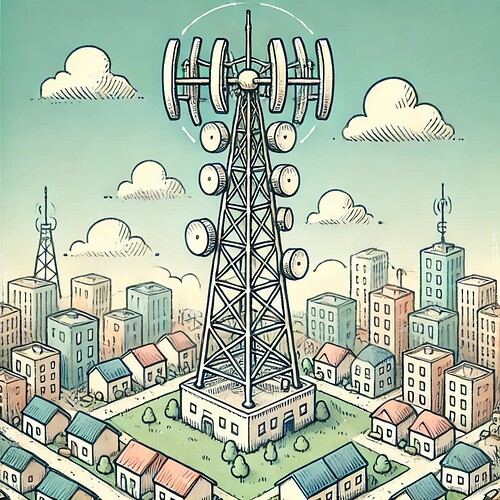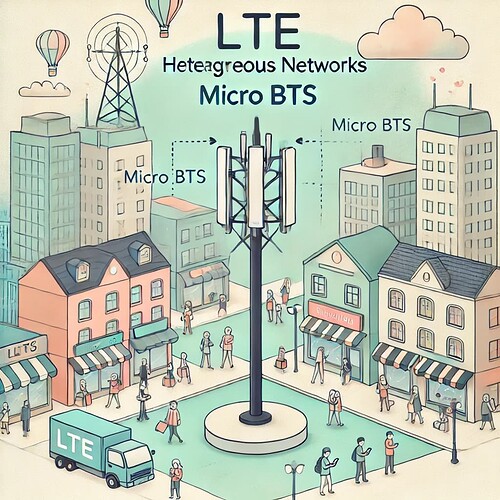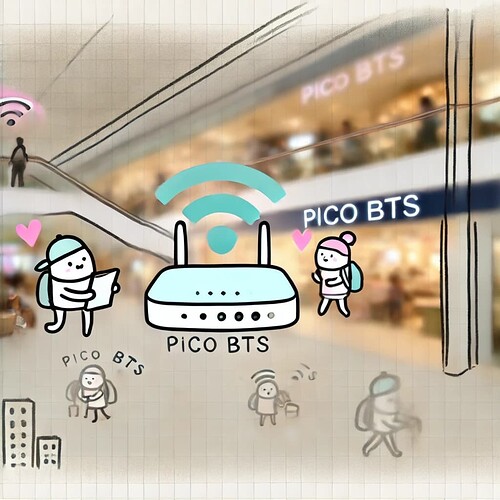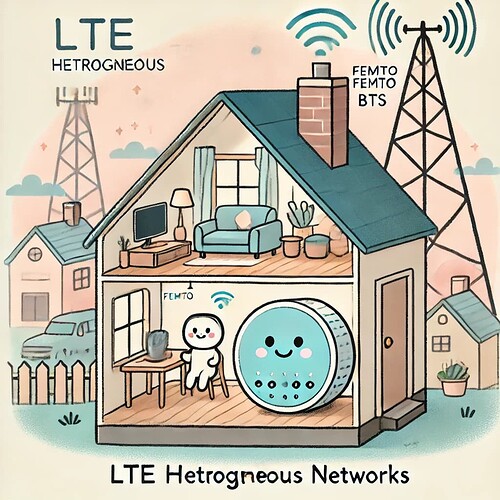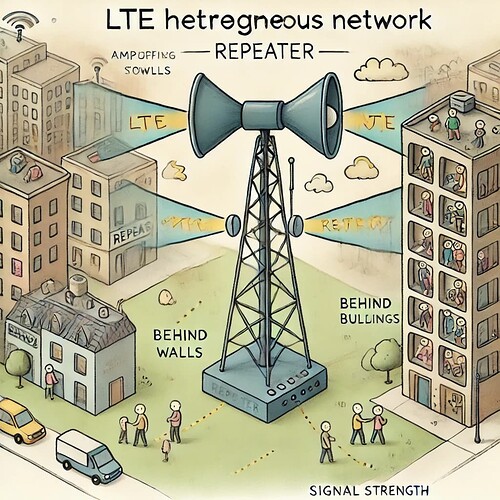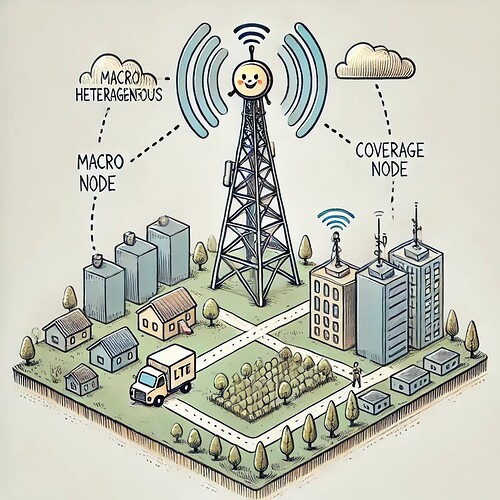This topic presents in a very simplified way all the main concepts that should be understood by those who know LTE.
LTE Heterogeneous Networks
LTE Heterogeneous Networks (HetNets) improve network performance by combining different types of base stations and equipment to enhance coverage and increase capacity. Macro BTS stations serve as the backbone, delivering wide-area coverage from elevated locations with high power to support thousands of users across vast regions. Small cells - including Micro BTS, Pico BTS, and Femto BTS - target specific areas to improve connectivity based on demand. Micro BTS units boost capacity in busy spots like city streets or stadiums, while Pico BTS, slightly smaller, provide reliable coverage in high-demand indoor spaces like shopping malls or offices. Femto BTS, the smallest type, offer focused coverage in homes or small offices, strengthening the signal in places where outdoor coverage may be weak. Repeaters extend the network by amplifying and rebroadcasting existing signals to reach areas with physical obstacles. Relay Nodes expand network reach further by picking up signals from Macro BTS stations and relaying them to remote locations where direct coverage may not reach. Together, these components create a flexible, efficient network that meets diverse coverage needs and adapts to varying usage patterns.
![]() LTE Heterogeneous Networks are like a city filled with different helpers working to make sure everyone can stay connected, wherever they are. The Macro BTS towers are like giant speakers placed high up on buildings or towers, ensuring people across the city can hear the signal. Small cells are special helpers for specific places: Micro BTS units are like medium-sized speakers on street poles in busy areas, helping people in crowded spots stay connected. Pico BTS are smaller speakers placed inside large buildings like malls or offices, giving people a strong signal indoors. Femto BTS, the tiniest speakers, are used in homes or small offices to make sure the connection is strong inside, even if outdoor coverage is weak. Repeaters work like loudspeakers that pick up weak signals and make them louder to reach areas with obstacles. Finally, Relay Nodes act like messengers, taking the signal from the main speakers and carrying it to people on the outskirts of town where the signal doesn’t reach directly. Together, all these different “helpers” make sure the whole city has a strong, clear connection, no matter where people are.
LTE Heterogeneous Networks are like a city filled with different helpers working to make sure everyone can stay connected, wherever they are. The Macro BTS towers are like giant speakers placed high up on buildings or towers, ensuring people across the city can hear the signal. Small cells are special helpers for specific places: Micro BTS units are like medium-sized speakers on street poles in busy areas, helping people in crowded spots stay connected. Pico BTS are smaller speakers placed inside large buildings like malls or offices, giving people a strong signal indoors. Femto BTS, the tiniest speakers, are used in homes or small offices to make sure the connection is strong inside, even if outdoor coverage is weak. Repeaters work like loudspeakers that pick up weak signals and make them louder to reach areas with obstacles. Finally, Relay Nodes act like messengers, taking the signal from the main speakers and carrying it to people on the outskirts of town where the signal doesn’t reach directly. Together, all these different “helpers” make sure the whole city has a strong, clear connection, no matter where people are.
Skip to: Roadmap to LTE
Heterogeneous Networks Introduction
LTE Heterogeneous Networks (HetNets) combine various types of base stations, equipment, and technologies working together to improve network coverage, capacity, and efficiency. By using various sizes and types of base stations and distributing data traffic, HetNets enhance connection stability, speed, and coverage, meeting the diverse needs of users in different environments (enhancing the overall performance and user experience in the network).
![]() Imagine a city where everyone wants to talk on their phones, watch videos, or play games online. To make sure everyone gets a good connection, the city uses different types of “signal helpers” placed around town. Some are big and cover large areas, while others are small and help in busy places. By working together, these signal helpers make sure everyone in the city can stay connected without problems.
Imagine a city where everyone wants to talk on their phones, watch videos, or play games online. To make sure everyone gets a good connection, the city uses different types of “signal helpers” placed around town. Some are big and cover large areas, while others are small and help in busy places. By working together, these signal helpers make sure everyone in the city can stay connected without problems.
- Search Forum
 LTE Heterogeneous Networks (HetNets)
LTE Heterogeneous Networks (HetNets) 
Macro BTS
A Macro Base Transceiver Station (BTS) is a large, high-capacity base station providing wide-area LTE coverage. Antennas for Macro BTS are typically mounted on towers or rooftops at heights of 30 to 60 meters to maximize reach. The Macro BTS equipment is typically housed in outdoor cabinets, weighing around 200-300 kg. Operating at high power levels, usually 20-40 watts per sector, a Macro BTS supports thousands of users across 3-4 sectors. These stations provide coverage over broad areas, forming the core of LTE networks in urban, suburban, and rural settings. Macro BTS are the primary backbone of the LTE network, handling most of the traffic and covering extensive geographical areas.
![]() A Macro BTS is like a giant radio tower in the middle of the city. It stands really tall, on big towers or tall buildings, so it can send signals over a large area, like a whole neighborhood or even an entire town. It’s powerful, like a loudspeaker, and can help thousands of people connect at the same time. Macro BTS units are the main “helpers” of the city and make sure the signal reaches as far as possible. It covers wide areas and handles lots of traffic, making sure everyone can connect from far away.
A Macro BTS is like a giant radio tower in the middle of the city. It stands really tall, on big towers or tall buildings, so it can send signals over a large area, like a whole neighborhood or even an entire town. It’s powerful, like a loudspeaker, and can help thousands of people connect at the same time. Macro BTS units are the main “helpers” of the city and make sure the signal reaches as far as possible. It covers wide areas and handles lots of traffic, making sure everyone can connect from far away.
- Search Forum
 LTE Macro BTS
LTE Macro BTS 
Micro BTS
A Micro BTS is a smaller, medium-power base station designed to add coverage in smaller, more specific areas with moderate data demand, like streets or business districts. Antennas for Micro BTS are generally installed at lower heights, around 10-15 meters, on poles or building walls. The equipment itself is compact, typically weighing 20-30 kg. Micro BTS units operate at power levels of 1-10 watts per sector and support hundreds of users within a single sector. Micro BTS is ideal for filling coverage gaps in high-traffic areas. It is typically used to enhance capacity and fill coverage gaps in areas where macro BTS signals are weak or congested.
![]() A Micro BTS is like a smaller tower or pole on the street. It helps boost the signal in busy parts of the city, like shopping areas or business districts, where lots of people need a strong connection. It doesn’t cover as much space as the big Macro BTS, but it helps make the signal better where there are lots of people. Micro BTS units make sure everyone in crowded places can get online smoothly.
A Micro BTS is like a smaller tower or pole on the street. It helps boost the signal in busy parts of the city, like shopping areas or business districts, where lots of people need a strong connection. It doesn’t cover as much space as the big Macro BTS, but it helps make the signal better where there are lots of people. Micro BTS units make sure everyone in crowded places can get online smoothly.
- Search Forum
 LTE Micro BTS
LTE Micro BTS 
Pico BTS
A Pico BTS is a compact, low-power base station for very small coverage areas such as indoor locations, malls, or transportation hubs. Pico BTS equipment is lightweight, around 2-5 kg, and is small in size, typically 30-40 cm tall. Operating at power levels of 100-250 milliwatts per sector, Pico BTS units support up to 100 users within a single sector. These stations help improve network performance in densely populated indoor environments, boosting signal strength and capacity in high-demand spots.
![]() A Pico BTS is even smaller, like a little box inside big buildings, like malls or train stations. It’s placed in spots where lots of people gather indoors and need a good connection, like a mini Wi-Fi router for LTE. Pico BTS makes sure people inside can get a strong signal without interruptions. They boost the signal in places where many people need a strong connection, like inside a mall.
A Pico BTS is even smaller, like a little box inside big buildings, like malls or train stations. It’s placed in spots where lots of people gather indoors and need a good connection, like a mini Wi-Fi router for LTE. Pico BTS makes sure people inside can get a strong signal without interruptions. They boost the signal in places where many people need a strong connection, like inside a mall.
- Search Forum
 LTE Pico BTS
LTE Pico BTS 
Femto BTS
A Femto BTS is a tiny, low-power base station designed for personal or small office use, providing LTE coverage within a limited range of about 10-20 meters. About the size of a home Wi-Fi router, a Femto BTS stands around 20-30 cm tall and weighs 1-2 kg. With power levels of 10-100 milliwatts, it supports up to 10 users within a single sector. Femto BTS units are ideal for extending LTE coverage indoors in homes or offices with weak outdoor signals. Femto BTS are the smallest type of base stations, often used in homes or small offices. They provide localized coverage and improve indoor signal quality, connecting to the LTE network via a broadband internet connection.
![]() A Femto BTS is like having your own mini cell tower at home. It’s a tiny device, about the size of a Wi-Fi box, and it helps you get a strong LTE signal in your house. It’s perfect for places where the outdoor signal might not reach very well, like in basements or far from the main towers. Femto BTS makes sure you can make calls or go online smoothly at home. Femto BTS are the smallest of all, like little helpers in homes or small offices. They make sure you have a good signal indoors, connecting to the internet through your home broadband.
A Femto BTS is like having your own mini cell tower at home. It’s a tiny device, about the size of a Wi-Fi box, and it helps you get a strong LTE signal in your house. It’s perfect for places where the outdoor signal might not reach very well, like in basements or far from the main towers. Femto BTS makes sure you can make calls or go online smoothly at home. Femto BTS are the smallest of all, like little helpers in homes or small offices. They make sure you have a good signal indoors, connecting to the internet through your home broadband.
- Search Forum
 LTE Femto BTS
LTE Femto BTS 
Repeater
A Repeater amplifies existing LTE signals to extend their reach by retransmitting them, which is particularly useful in locations with physical barriers. Repeaters vary in size and power but are typically compact, weighing around 1-5 kg. They operate with power levels from 100 milliwatts to 5 watts. While Repeaters do not create new coverage areas, they strengthen the existing signal, supporting hundreds of users in areas with weak signals, such as within buildings. It is a device that amplifies and retransmits signals to extend coverage. In LTE HetNets, repeaters help strengthen and extend the reach of the network, especially in areas where the signal is weak or obstructed.
![]() A Repeater is like a signal booster. Imagine you’re in a part of a building where it’s hard to hear a sound clearly. A Repeater picks up the LTE signal, makes it louder, and rebroadcasts it, so people can connect better in hard-to-reach spots. It doesn’t create a new signal, but it makes the existing one stronger, helping people get a clear connection even behind walls or in bigger buildings. It is like a megaphone that makes the signal louder. It grabs a weak signal and amplifies it, extending the network’s reach so even more people can connect.
A Repeater is like a signal booster. Imagine you’re in a part of a building where it’s hard to hear a sound clearly. A Repeater picks up the LTE signal, makes it louder, and rebroadcasts it, so people can connect better in hard-to-reach spots. It doesn’t create a new signal, but it makes the existing one stronger, helping people get a clear connection even behind walls or in bigger buildings. It is like a megaphone that makes the signal louder. It grabs a weak signal and amplifies it, extending the network’s reach so even more people can connect.
- Search Forum
 LTE Repeater
LTE Repeater 
Relay Node
A Relay Node extends network coverage by relaying signals from a nearby Macro BTS to users in remote or hard-to-reach locations. Relay Nodes are generally compact, often weighing around 10-20 kg. They operate at 5-10 watts and serve hundreds of users within one or two sectors. Unlike Repeaters, Relay Nodes create new coverage areas, making them useful for connecting areas that lack direct access to the main network. It is a type of base station that extends coverage by receiving and forwarding signals between users and the main base station. Relay Nodes are used in LTE HetNets to enhance network performance and coverage, particularly in hard-to-reach areas.
![]() A Relay Node is like a relay runner in a race - or a courier that helps deliver signals further. If you’re far away from the main signal, the Relay Node picks up the signal from a nearby big tower and passes it along to you, like handing off a baton. It’s especially helpful for areas far from the main towers, like parks or on the edges of the city. Relay Nodes make sure people in these areas get a strong signal, even if they’re farther from the main network. It picks up the signal from one base station and passes it on to extend the coverage, especially useful in hard-to-reach areas.
A Relay Node is like a relay runner in a race - or a courier that helps deliver signals further. If you’re far away from the main signal, the Relay Node picks up the signal from a nearby big tower and passes it along to you, like handing off a baton. It’s especially helpful for areas far from the main towers, like parks or on the edges of the city. Relay Nodes make sure people in these areas get a strong signal, even if they’re farther from the main network. It picks up the signal from one base station and passes it on to extend the coverage, especially useful in hard-to-reach areas.
- Search Forum
 LTE Relay Node
LTE Relay Node 
That’s it. ![]()
-
Continue reading: Roadmap to LTE - Network Planning
-
Or back to: Roadmap to LTE
